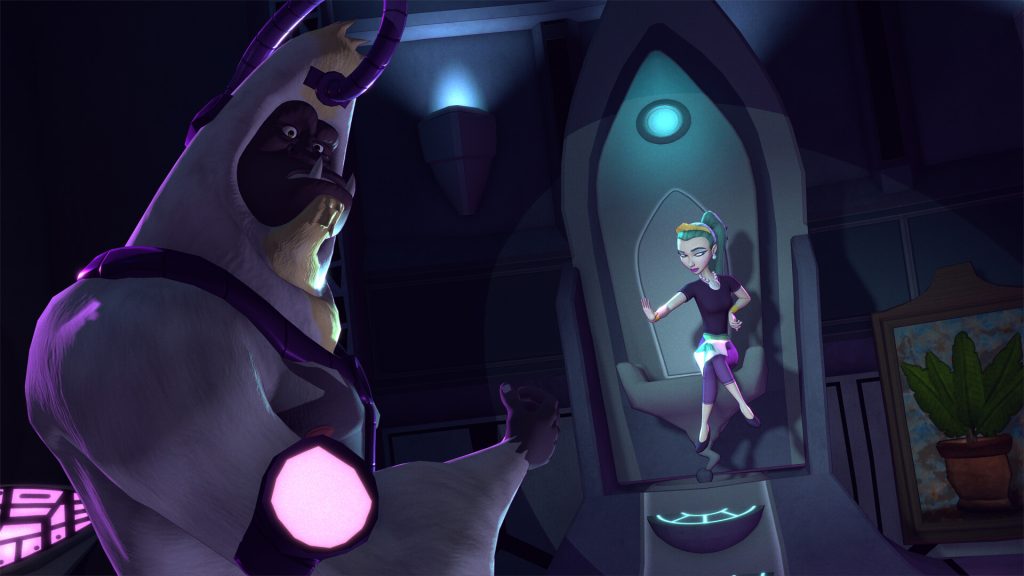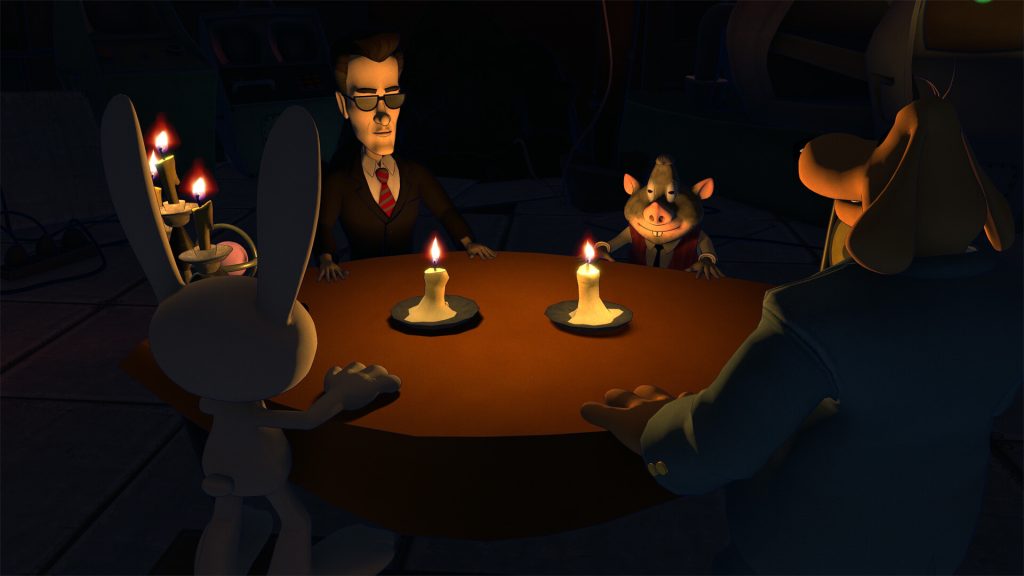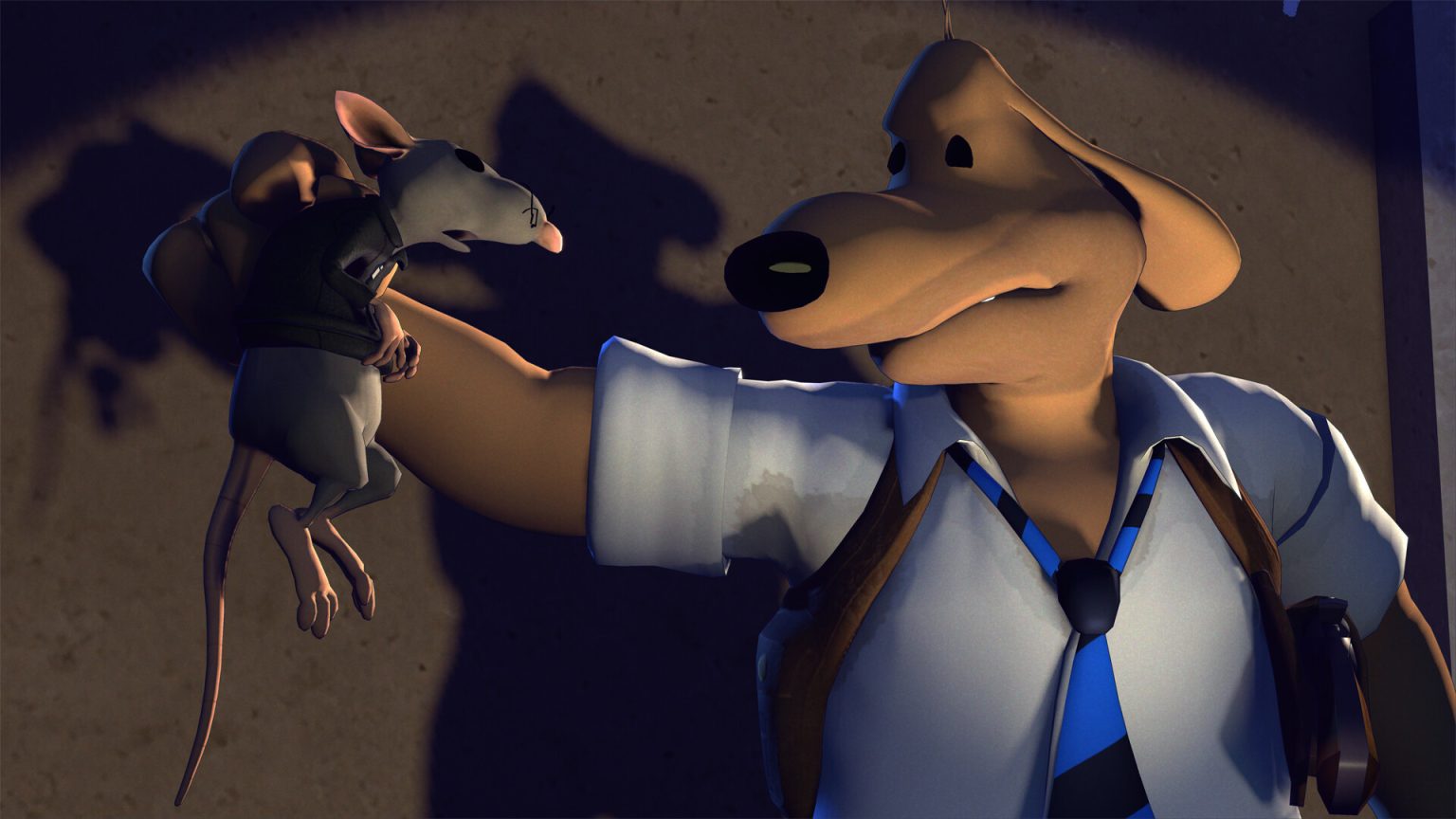Where Have You Been All My Life?
Last year, I wrote about my desire to find a game I could play while holding a baby, which led me to the chill point-and-click adventure Return to Monkey Island. It was the latest in a long-running series, but the first release in over a decade due to behind-the-scene issues with studio acquisitions and production rights. In my efforts to continue down the point-and-click rabbit hole, I saw countless recommendations for the Sam & Max series, particularly for fans of Monkey Island. After all, both share their LucasArts origins, dating back to the early 1990s.
Although Sam & Max: The Devil’s Playhouse Remastered isn’t a new adventure like Return to Monkey Island, it and the series as a whole were still new to me. Having never played the 2010 original (which, fun fact, was one of the very first apps to launch on iPad!) or other, earlier games in the series, I was both very excited to give it a shot and slightly worried about how lost I might feel in the lore.
I’m happy to report that Sam & Max: The Devil’s Playhouse Remastered is an absolute blast to play through and a shining example of a style of game that has sadly seen its share of the marketplace shrink over the years. Now that I’ve gotten a taste, I’ll no doubt be backtracking through the Sam & Max catalog, and I recommend anyone who longs for classic point-and-click fun to do the same!

Max & Sam, Sam & Max
In The Devil’s Playhouse, you play as the titular Sam & Max—no surprises there. That said, the roles they each play can lead to some unexpected interactions and interesting puzzle-solving.
Sam, a 6-foot-tall anthropomorphic dog in a full suit and tie is a bit more of the straight man—er, mutt. When navigating the quirky, cartoonish world, players control Sam as he interacts with objects and strange NPCs galore. In typical point-and-click fashion, there are only a few selectable items per screen, with many serving as distractions or red herrings. However, the dialogue trees for many of your friends and enemies serve as guides for the path forward and often require careful thought to find the proper prompt. In addition, you’ll naturally acquire trinkets and tools along the way to help you on your journey. Figuring out exactly how these (sometimes bizarre) items combine with your environment is of course a true hallmark of these types of games; here, these moments are clever and enjoyable almost every time.
Speaking of bizarre items, Max, a knee-high, naked, anthropomorphic rabbit has his fair share as well. In what appears to be a new development from previous games in the series, Max has psychic abilities that allow him to control the “Toys of Power,” which serve as the primary throughline for this particular installment.
Although Max doesn’t move around the environment like Sam, when switching to his controls, the player has an assortment of toys at their disposal, each with its own reality-changing twist. A ventriloquist dummy, for example, allows Max to make it seem as though anyone he chooses says anything he chooses, while a classic toy rotary phone grants teleportation powers to any phone for which Max knows the number. These toys and their associated abilities are some of Sam & Max’s most important tools when it comes to solving puzzles and getting out of sticky situations, and each one surprised me with the creative ways they were integrated into the gameplay. Of course, as with any great power, there comes (along with great responsibility), a bad guy trying to steal it. In this case, that villain is General Skun-ka’pe, an alien gorilla with a mean streak.

We Come in Peace?
The Devil’s Playhouse Remastered, which consists of five episodic chapters originally released in 2010, starts with a flash-forward scene where our heroes are imprisoned on General Skun-ka’pe’s spaceship and must stage a high-stakes escape. It’s a clever way to introduce players to the game without making them feel like a complete novice. Being thrown into the fire straight away is also a great way to get invested in the story, as the flash-forward lasts just a few minutes and leaves players wondering how Sam and Max got there in the first place.
The game is fully voice-acted, with a wide array of over-the-top, goofy people and creatures to meet. The depth and variety of these characters make for an immersive experience, especially when combined with the remastered visuals. I found myself extremely impressed by the production value, and though the cartoon style doesn’t exactly push the limits of visual media, almost everything here is polished. I say almost everything because one hang-up I did have was with a few of the character models. Some, particularly the ever-present mole-people, didn’t quite seem to get updated effectively and look like they’re still stuck in 2010.
The same goes for the humor, which I found to be somewhere between irreverent and juvenile. There were moments I let out a chuckle to be sure, but for a game that certainly isn’t taking itself too seriously, the tone was a tad inconsistent while also feeling somewhat dated. None of the jokes crossed a line or veered into inappropriate territory, but some of the writing didn’t feel especially modern. Sam & Max reminded me of a few other franchises from the early 2000s; the story felt like it would’ve been at home in a show like Jimmy Neutron. Your mileage may vary on the mix of nostalgia and comedy, but my personal hopes for some sharper writing fell short.

I Stole Max’s Brain!
What really struck me about my time with Sam & Max is its skilled subversion of expectations. I came into The Devil’s Playhouse thinking I’d play through an average point-and-click adventure with a heavy emphasis on laughs. What I didn’t expect was such strong gameplay where the comedy takes a backseat.
Each chapter introduced new concepts and kept me searching for answers—often for several hours, which ended up a nice surprise. What I thought might be bite-sized vignettes actually could have been standalone titles, and I wouldn’t have been upset! Particularly for the $19.99 price tag, there’s more than enough content to keep people satisfied, as my journey easily crossed the 20-hour mark.
My favorite mechanics included chapter two’s time travel theme and chapter three’s interrogation mode (to go along with its brief tone shift to full-on noir), which was a welcome departure from the standard point-and-click fare. Not to reveal a 15-year-old game’s secrets, but “The Tomb of Sammun-Mak” in the game’s second segment blew me away with its creativity and flawless pacing as the game guides players through five(!) different timelines. What starts as a direct continuation of chapter one’s “current day” story moves to a section where our furry friends discover old film reels of their ancestors “Sameth” and “Maximus” on their quest to steal the Devil’s Toybox.
Each of the four reels transports the player to a different point in their pursuit and can be accessed at any time via Max’s psychic powers. Instead of following the beats of the story in chronological order, you must identify the part in each story where you can no longer progress and need to jump timelines to either gain a new item or find clues on how to backtrack. The winding road was shockingly smooth and, as with most great time travel stories, had me wondering how anyone could write such a convoluted story that somehow made perfect sense.

Freelance Police Forever
In such a high-quality game, possibly what I appreciated most was that I was able to get through it without needing to consult outside sources. Though I found myself stuck a number of times, I never became too frustrated to continue or unable to make progress. Every solution, no matter how immediately clear it was, followed the world’s logic and gave me great pleasure to discover. There was a perfect balance of working through conversations, finding unique uses for seemingly innocuous items, and, when all else failed, bending the rules with Max’s psychic powers.
I should note that Sam and Max often speak aloud to each other to nudge the player along if and when you get stuck for an extended length of time. I was impressed by the subtle ways in which they would seemingly repeat information at the perfect moment or offer a new hint if the last one didn’t lead to a breakthrough, and you can even modify the frequency or turn this feature off completely. In-game tips eliminate any need to search for help online and take you out of the flow, but these types of features aren’t as commonplace as they should be. Having the option here was a big plus for me!

Final Thoughts
When it comes to point-and-click puzzle games, this is a nearly flawless example of how to tell an engaging story while giving players plenty to do and not holding their hand along the way. I find it hard to imagine a much better structure for the genre, and though some of the humor and characters weren’t to my taste, those minor gripes are far outweighed by the positives.
Whether you missed Sam & Max in the ‘90s and aughts, or you’re looking for an excuse to revisit the series, it’s hard to go wrong with The Devil’s Playhouse Remastered.
Score: 9.0/10
Sam & Max: The Devil’s Playhouse Remastered, originally developed by Telltale Games and remastered by Skunkape Games, is available now for PC, Xbox Series X/S, PlayStation 5, and Nintendo Switch. MRSP: $19.99.
Disclaimer: A review code was provided by the publisher.
Zack has been hooked on games ever since his older brother taught him where to find the secret warp whistles in Mario Bros. 3. He has never felt more joy than when Yoshi congratulated him on getting 120 stars in Mario 64 or more sadness than when he played Kingdom Hearts 3 after waiting 14 years for it. Zack mails a letter to Nintendo every day asking them to bring back Chibi Robo and will gladly tell you all about why it’s one of the greatest games of all time. He was hoping that writing for the site would help him get through his backlog, but it actually just made it worse now that he’s hearing about so many more great hidden gems. Oops…










